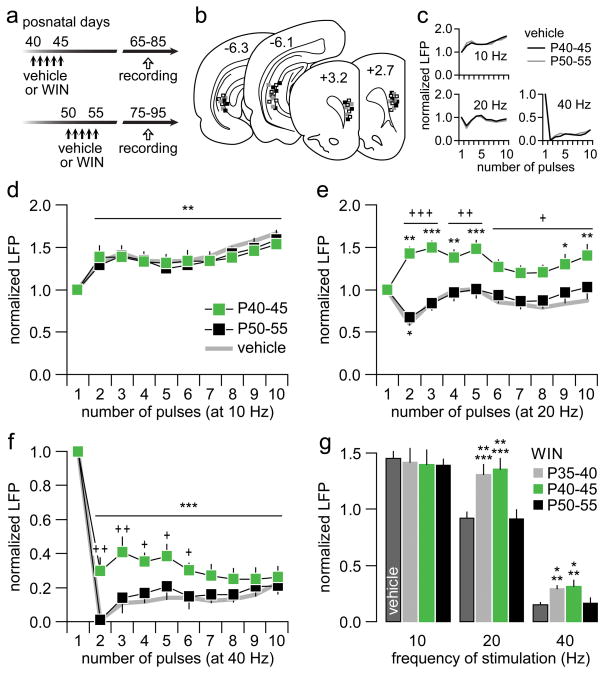Figure 3.
(a) Experimental design for assessing the impact of WIN exposure at 2 age groups of adolescent rats. Note that all prefrontal LFP recordings were conducted in adulthood (white arrow). (b) Summary of the recording and stimulation sites as determined by means of histological analyses from Nissl-stained sections (vehicle: white; P40-45 WIN: back; P50-55 WIN: gray). (c) Both vehicle-treated groups exhibited comparable patterns of prefrontal LFP response to ventral hippocampal train stimulation (n=4 per age group). (d) As in the P35-40 age group (Fig 1), WIN treatment during the P40-45 (n=7) and P50-55 (n=7) adolescent periods did not alter the characteristic facilitation of prefrontal LFP response to ventral hippocampal stimulation at 10 Hz (main effect of pulse number, F(9,120)=4.5, p<0.0001, two-way ANOVA; **p<0.005 vs. first pulse, LSD post-hoc test). The thick gray line summarizes the pooled data obtained from both vehicle-treated groups (n=8). (e) At 20 Hz, two-way ANOVA revealed a significant main effect of age (F(1,120)=81, p<0.0001) and age × pulse number interaction (F(9,120)=2.1, p=0.034). Rats that received WIN treatment at the P40-45 period responded with a marked prefrontal LFP facilitation (*p<0.05, **p<0.005, ***p<0.0005 vs. first pulse, LSD post-hoc test) as seen in the P35-40 WIN-treated group (Fig 1). In contrast, rats that received WIN treatment after P50 exhibited the normal pattern of transient LFP inhibition (*p<0.03 vs. first pulse, +p<0.05, ++p<0.005, +++p<0.0005 vs. P40-45, LSD post-hoc test). (f) A robust inhibition of prefrontal LFP was observed in both P40-45 and P50-55 age groups at 40 Hz (main effect of pulse number: F(9,120)=33.5, ***p<0.0001, two-way ANOVA). However, the magnitude of inhibition in the P40-45 age treatment group was significantly less pronounced to that from the P50-55 WIN-treated group (main effect of age: F(1,120)=25.9, p<0.0001; +p<0.05, ++p<0.005, +++p<0.0005 vs. P50-55, LSD post-hoc test). (g) Summary of the LFP response recorded in the adult PFC of the 3 adolescent WIN-treated groups. The average values were calculated from pulses 2 to 10. Data from all vehicle-treated rats in the P35-40, P40-45, and P50-55 age groups were pooled. The abnormal facilitation of prefrontal LFP response at 20 Hz observed in P35-40- and P40-45-treated rats is absent in the P50-55 age treatment group (***p<0.0005 vs. vehicle, **p<0.005 vs. P50-55, LSD post-hoc test; one-way ANOVA, F(3,35)=10.9, p<0.0001). Similarly, the attenuation of prefrontal LFP at 40 Hz was observed only when WIN exposure occurred during P35-40 or P40-45, but not after P50 (**p<0.001 vs. vehicle, *p<0.01 vs. P50-55, LSD post-hoc test; one-way ANOVA, F(3,35)=8.1, p<0.0005).

